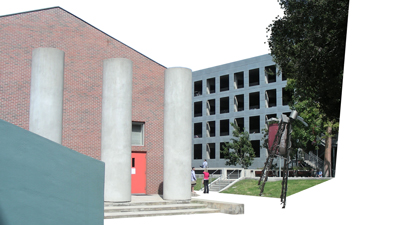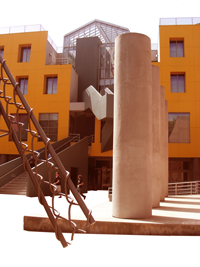You are in: Home page > Magazine Archive > The Theatricality of the University Campus.

Paolo Strina
The Theatricality of the University Campus.
American Lessons

F. Gehry, post-modern architectural details of the Loyola Law School of Los Angeles.
Abstract
Direct
experience gained in one of the most prestigious scenarios of American academia
helps create a typological profile of the campus, a place that produces culture and that, originally, was set against the city according to a principle of
anti-urban life. According
to the American ideal, nowadays the campus represents a completed city part that wishes to impress the
spectator – whether student, city inhabitant or visitor – by heightening
emotional effects through its capacity to introject the complex functional
programme of the entire urban settlement, and to communicate by means of
thespian figures.
What
can be more eloquent to describe a fact than an image, especially if it is urban, like a city or a fragment of a city?
In
his study Images in the Modern City,
Walter Benjamin attempts to immortalize places that are notably different from
one another in terms of identity culture, grasping their peculiarities from
direct experience, by using narrative snapshots focusing on sociological and
anthropological aspects, as well as politics.
In
tune with the literary reference, an architect recognizes the distinctive
characteristics of a city by laying hands on the forms that subtend functions
and trigger collective behavioural phenomena, as well as the actual image of
the subject.
In
the vast seas of the urban theatre, an allegorical image that well describes
the current condition of the contemporary European city and not only, oddities
of character are portrayed by protagonists of the urban scene emerging from the
landscape of the indistinct.
These
personages, often related to specialized containers that replicate the
architectural type of the ‘grand machine’, if corroborated by supporting
elements that guarantee multi-functionality of the whole, instil an effect of
urban centrality that is latent in the settlement composite.
From
them are derived places with a differentiated role according to their
transcalar relational capacity with the urban whole and the stretches of the
territory. Following this principle, it becomes possible to codify centralities
reacting with city parts, the metropolitan landscape and multi-centric systems
of relations.
The
University Campus site. imported non-manneristically from the American model,
like various polarities that catalyse extra-urban flows, embodies a potential
centrality of a metropolitan type that can be adopted as a -pilot neighbourhood to try out new urban models of an integrated nature, to be set up
using regeneration policies based on the technique of densification.
“The
theme of urban theatricality emerges as soon as the city ceases to expand and
is forced to gaze upon itself, thereby discovering the lack of image, as well
as liveability and belonging, that have marked its recent development. How can
we use the tools of architecture and the urban project to recover a condition
in which the city, in particular its suburbs, once again becomes a theatre of
the social relations and representativeness that animate it?”
The
context described is the result of an anti-city attitude rooted in urban
planning and development strategies, out of which often come modern university
campuses strongly linked to the infrastructure but equally strongly separated from
the compact mass of the city.
The
American lesson, centred on the architectural campus type, at one and the same
time rehearsal room, backstage and stage for elitist communities of the of the Ivy League ilk, teaches how originally the university field-base was conceived
as an alternative to the city, to the extent of reproducing the entire
programmed complexity within a sort of student phalanstère. An analogical comparison following the theatrical
metaphor leads to a parallel with Classical and and late Renaissance ancient
theatre, where the principle of introversion and isolation with respect to the
remaining urban community places reigns. Since
the advent of the departmental institution and the consequent increase in the
range of courses, a greater need has arisen for specific spaces for each
disciplinary area, corresponding to a contextual explosion of the form of the
eighteenth-nineteenth century chromosome. The morphological upshot is a modern
settlement divided and disseminated in a strict interface with the connective
fabric of the expanding city; extroverted in terms of the local facilities that
the campus can avail itself of, and introverted as far as interchangeable group
and mass structures are concerned.
There
are many modern campus models in the USA, in which can be gleaned the set of
fragmentary plastic and expressive forms, components of a sort of urban
dramaturgy; including the Loyola Law
School of Los Angeles (1920). A genuine architectural revival in the form
of a patchwork of classical-style volumetric elements, set out like a stage
set. An interesting interpretation can be made of the interview with the
designer, F. Gehry, included as a video-documentary available on the university’s
official internet site, in which he appears sitting in a director’s chair; an
allegorical image of the architect-director-playwright.
The
Gehry of Loyola looks like the ancestor of the Gehry who designed the Ray and Maria Stata Center Pavilioninside the Massachusetts Institute of Technology in Boston.The
MIT is a cutting-edge university institute, specializing in technological
research and featuring student services that guarantee a complete and unique life experience,
inside a proper neighbourhood that is today completely encircled by the suburbs
beyond the Charles River.
The
afore-mentioned campus is the subject of the preselected snapshot it derives
from, via a caption description using key words, morpho-typological
characteristics of the contemporary American field -base.
Architectural
layout:
founded
in 1861, the campus lies on the right bank of the Charles River, near the
confluence with the Mystic River on which the city of Boston rose in 1630. The
main neoclassical block features an open courtyard with double wings lying
along two governing axes (East-West, North-South) marked by two ‘pantheons’.
The latter work as both a compositional pivot and, with their denotative domes,
as landmarks indicating the monumental entrances to the historical block.
Meanwhile, the green spaces instantly acquire notable importance in terms of
both size and role, as demonstrated by the park nestling inside the courtyard
overlooking the Charles River. To the West, directly connected to the urban and
extra-urban traffic artery that links up with the historical city on the other
side of the river, is the main entrance. The access is characterized by a
pronaos that acts as a filter between the ‘Piranesian’ hall, the road, and the
linear frontal park, a site of aggregation for resident students. The
neoclassical nature of the original building is transmitted by the typical
architectural elements, archetypes of different styles, such as pediments,
colonnades, friezes and trabeations, as well as the rhythms of the spatial bays
emphasized in perspective by pilasters. To the East, the modern features, which
have evolved from the nineteenth century until today, inflect the formal and
typological characteristics of the original building. Stylistically
heterogeneous linear and punctual elements, (from the rational to hi-tech,
passing via the Brutalism that marked Boston in the 19th century.
with original creations like the City
Hall by Kallmann McKinnell & Knowles and the Government Service Center by Paul Rudolph) composed together,
arrange a sequence of conclusive but permeable spaces that echo the scheme of
courtyards/furnished internal piazzas.
To
the West the park is similar in type to a green mall, bordered to the South by
a promenade lined with residences, and to the North by a terrace of
complementary services and the campus’s aggregative activities. Despite the
strong relationship between the buildings and the road, the confine is
imperceptible, aside from the natural one to the South created by the river.
This aspect encourages the facilities to spread outside the original complex
while maintaining continuity with it.
Polarity
The
American campus is also a tourist destination: the top students its guides and
enthusiastic promoters. Its historical value and contemporary quality are
attractive factors for the masses. The visitor is fascinated by the
architectural constructions that punctuate the fabric of the university-city.
In this specific case, the building-monument of technology and science is the Ray and Maria Stata Center Pavilion, a
symbol of hi-tech that predominantly houses electronic engineering and IT labs,
other labs researching artificial intelligence and teaching rooms. In pure
Gehry style, the building is a manifesto of the institute’s technological and
expressive avant-garde.
This
architectural example, together with other elements characterizing the campus’s
modern developmental phases, answers pure visibilist aesthetic requisites.
Residence
and Aggregation
The
residential facility, commonly associated with the typically Anglo-Saxon
Brotherhood House concept, is concentrated in a site outside the educational
and operational centre; it follows a serial and sequential composition
decidedly eclectic in terms of its volumes that marks the bank of the Charles. Their arrangement creates a border element
which, by complementing the specular structures lining the road, defines the
typology of the mall overlooking the ‘rotunda’ of the main entrance. The
centre of the mall, in pure Jefferson style, is enlivened by the Kresge Auditorium designed by Eero
Saarinen, out from which stretch the open-air sports and recreational areas.
The
choice of the site brings an idea of ‘student village’ in which comfort is
guaranteed as much by the quality of the residential spaces as the available
services. The line of residences, dialoguing with the interior of the mall and
with the river towards Memorial Drive, stands out for its ‘dual-fronts’
eminently expressed by Baker House,
the student hall of residence designed by Alvar Aalto in 1946. The organic
nature so typical of Aalto’s style breaks up the rational serial style of the
earliest residential blocks that open the volumetric enfilade. This is a
student hall of residence for freshmen, devoid of any institutional symbol as
the designer wished. The building stands out starkly against the neoclassical
language of the background chromosome. The relationship with the natural
landmark of the river is reflected in the undulating façades answering
requisites of visibility, adherence and rapport with the landscape, the
sunlight and consequent interior comfort, as well as variety in distribution.
In fact, in line with the design scheme, the single, double and triple rooms
with a total of 353 beds, all enjoy a view of the river and great natural
light.
The
variety in the types of room, which is also reflected in the façade, featuring
a particular double curve shape, meant that common spaces could be created
inside for leisure rooms and small refectories.
The
residence described is an expression of ante
litteram social-housing.
Mens et
Manus:
motto
of the MIT and mantra of the students and lecturers who inhabit it; manifesto
of a specialized, evolved place, the star of a work staged in the theatre of
urban forms.
Note
[1] http://www.festivalarchitettura.it/fa5_2013/festival/It/Tema.asp
Bibliography:
W. Benjamin, Immagini
di Città, Turin, 2007
I. Calvino, Lezioni
Americane, Turin, 2000
G. Canella, Il
Sistema Teatrale a Milano, Bari, 1966
G. Canella, L. Stellario D’Angiolini, Università, Ragione, Contesto, Tipo, Bari,
1975
K.
Christiaanse, K. Hoeger, Campus and the
City: urban design for the knowledge society, Zurich, 2007
M. Loi, Thomas Jefferson, 1734-1826. Primo Architetto Americano, Turin, 1993
C. Quintelli, La
Città del Teatro, Milan, 1995
P. Reed, Alvar Aalto.
1898-1976, Milan, 2007
PhD thesis: N. Montini, Tecnica di densificazione attraverso le centralità urbane di parti di
città, Parma, 2015
PhD thesis: A. Nolli, Tecnica
di densificazione attraverso le centralità urbane in sistema di relazione
policentrico, Parma, 2015
PhD thesis: P. Strina, Tecnica di densificazione attraverso le centralità urbane di tipo
metropolitano, Parma, 2015
Paolo Strina, architects, has a Ph.D title in
architectural composition at University of Parma. He is a member of a research
group Urban and Architectural Laboratory.

F. Gehry, post-modern architectural details of the Loyola Law School of Los Angeles.













